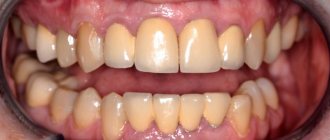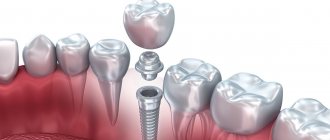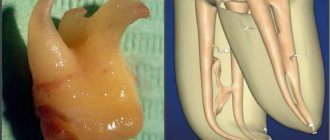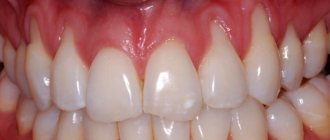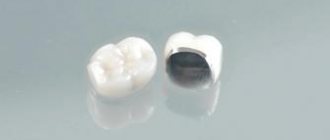Healthy teeth are firmly held in the gums by periodontium. Due to this feature, they can fluctuate freely in the gums, but such movements are not noticeable to humans. Even if you loosen the tooth with your finger, you won’t be able to feel that it is loose.
Thus, it turns out that a loose tooth is already obviously unhealthy. And it doesn’t matter at all whether a natural tooth is loose or a replacement implant of any format. From this material you will learn how dangerous it is to loosen an implant and what consequences can arise from this.
The ceramic lining on the crowns began to chip
The most likely cause is nocturnal bruxism. That is, in your sleep you clench your teeth and/or grind them uncontrollably. The reason for this is considered to be psychological stress.
Orthopedists often prescribe a night guard for these patients. Don't neglect her. It will cost money to have your teeth redone.
What to do? If you have these symptoms, your doctor will make a special night guard. It will need to be worn before bed to protect both the implants and teeth. At first it may cause slight discomfort.
Why might an implant become loose?
Looseness of the implant crowns can be caused by several reasons, and different parts of the prosthesis suffer. Sometimes it is the implant crown that begins to wobble relative to the abutment. In another case, the abutment is loose relative to the intraosseous part or the latter is loose relative to the jaw bone.
First of all, the solution to implant instability depends on the location of the problem. The reason may be incorrect fixation of the prosthesis initially during its immediate installation. If the doctor makes a mistake, the patient may suffer serious harm in the future.
Another common reason for the loosening of the prosthesis is ignoring the doctor’s recommendations for care and operating rules. Problems also often arise due to systemic problems with the patient’s health. The worse your health, the more serious problems will arise with your dentures.
Implant maintenance has become too expensive for me
Once every six months, it is recommended to have your teeth and implants professionally cleaned by a hygienist. The procedure is not very expensive (3000-6000 rubles), and in many clinics it is a mandatory item in the warranty program for implants. If you don’t take care of your implants at all (as well as healthy teeth), the risk of problems and complications increases. What to do? If you do not have the opportunity to visit a hygienist, focus on self-hygiene - this is not such a costly procedure. Check out our recommendations:
Types of crowns for implants
What kind of crowns are placed on implants? Like regular dentures, implant-supported dental crowns come in a variety of types depending on the material. Today, the most popular materials used in the manufacture of crowns on implants are ceramics and metal-ceramics. Their main difference, as the name suggests, is the presence or absence of a metal frame in the design. Recently, it has become popular, for example, to install zirconium crowns on implants - all-zirconium or ceramic restoration structures made on a zirconium frame.
- Ceramic
Dentures made of ceramics are usually recommended to be installed in the area of the front teeth. Such structures are highly biocompatible, which means they do not have any negative effects on the soft tissues of the oral cavity. Plus, they look exactly like natural teeth. Ceramic crowns are more transparent, so in this case an abutment will be made of ceramic or zirconium. - Zirconium
Implant Crowns made from this modern material are most in demand by specialists today. The secret of their popularity is simple: they combine good aesthetic qualities and high strength. - Metal-ceramic
Metal-ceramic is perhaps the most common material used for the manufacture of dentures. Metal-ceramic crowns on implants for chewing teeth are inexpensive and reliable. They usually require a metal abutment.
Why do crowns break and fall out?
- Service life has expired. The service life of any crown is limited. Upon completion, the crown is changed.
- Oral hygiene was not maintained. Lack of proper care and poor hygiene are a common cause of premature loss or breakage of a prosthesis.
- Mechanical impact. The prosthesis breaks or falls out if the permissible load is exceeded. You cannot chew nuts with prosthetic teeth or use them for other purposes than as a “handy tool.”
- The base tooth has deteriorated. Continued destruction of a damaged tooth can lead to the crown falling out - it is not fixed in any way.
- Poor quality work of a dentist or orthopedic dentist. Even minimal deviations from manufacturing technology, inaccuracies in size or geometric configuration, improper preparation of prosthetics - all this can lead to premature failure of the crown.
Even a perfectly manufactured and installed crown can accidentally fall out or break. To minimize the risk of losing it after dentures, undergo regular medical examinations with a dentist.
Why is this happening?
So, what causes a denture or crown to fly off? In some cases, the cause may be external physical influences or other force majeure circumstances. However, most often the “dog is buried” in the poor quality of the dentist’s work.
Poor quality cementitious mixture . If its composition, quantity and application technology are violated, then over time the cement loses its properties, begins to crack and the crown falls out;
during the manufacture and installation of a prosthesis or crown were incorrectly calculated In other words, the shape of the supporting tooth and the internal plane of the artificial tooth do not coincide and the prosthesis begins to balance, destroying not only the cement fixation, but also the tooth itself.
What should a doctor take into account in order to properly install a crown or dental bridge? There are a number of points:
- features of bite;
- the extent of the defect, its configuration;
- correct treatment of teeth before installing a prosthesis;
- correctly calculated crown height and shape.
What is an implant, and what part of the structure can fall out after installation?
A dental implant is a multi-component dental product that is inserted into the patient’s bone tissue and replaces the roots of a lost tooth. A mandatory stage of implantation is osseointegration, the process of creating anatomical and functional connections at the molecular level between the surface of the implant and bone structures. In simple words: the implant fuses with the bone and is securely fixed in the gum. It falls out extremely rarely.
Usually, the question of why a tooth implant fell out hides another problem - with one of the elements of the implanted structure.
Worth sharing:
- implant - a “tooth root” made of titanium or titanium alloy, directly implanted into the bone;
- gum former – a supporting element that guarantees the preservation of gum volume during the process of engraftment of artificial roots;
- abutment – an adapter for attaching a crown or prosthesis to a titanium implant;
- suprastructure is a collective term for abutments and gingival formers.
What is the best crown to put on an implant?
The answer to this question depends on the area being implanted and your budget. If we are talking about chewing teeth and the patient does not want to overpay, then the doctor will most likely recommend metal ceramics. Zirconium crowns for chewing teeth will undoubtedly be the best option. However, it is also more expensive. If prosthetics takes place in the so-called smile zone, then it is better to place a crown on a ceramic implant. She will look not only beautiful, but also absolutely natural.
Which is better, a crown or an implant?
When asking a similar question, patients most often mean the installation of dentures based on their own teeth and implantation. What is the difference between a regular crown and an implant? In order to install a conventional bridge, it is necessary to grind down the healthy teeth adjacent to the defect, which will begin to decay over time and the bridge will have to be lengthened. This cannot happen with an implant. Its installation does not affect the “neighbors” in any way, and its service life is not limited. Only the crown will have to be changed. The service life of crowns on implants is about 10 - 12 years, and in many cases reaches 15 years, while with traditional prosthetics, the crown must be changed every 5 - 7 years, grinding the teeth in a new way.
We will definitely help!
The circumstance when the crown came off was not a pleasant one. The patient experiences many problems - from difficulties chewing food to psychological discomfort. The absence of an element in the mouth affects the smile and diction: often a person begins to lisp or involuntarily whistle, which is why he tries to reduce communication with others to a minimum. Complexes arise, problems appear in the family and at work. Nowadays, it is difficult to achieve serious success without a well-groomed appearance and good health, the indicator of which is a beautiful smile. This means that the circumstances under which the crown may fall off must be excluded. This will be done by the experienced dentists of our clinic, who have had to deal with similar cases more than once. The main thing is to identify the correct cause, which X-rays will help with. When the crown comes off, the doctor will put the prosthesis in place if everything is fine with it, or make a new one if it is deformed. If the cause is in the tab, treatment will be required. In any case, our employees will make every effort to quickly and painlessly restore the integrity of the dentition.
- We use modern technologies and the latest generation drugs.
- We employ dentists with higher education and extensive experience.
- We comply with strict hygiene requirements and sanitary standards.
- Each department has its own laboratory facilities.
- The cost is quite affordable, many services can be obtained free of charge under compulsory medical insurance.
- There is a flexible system of discounts, and it is possible to pay for treatment in installments.
- The branches are located in close proximity to metro stations.
- We work seven days a week and on holidays, and visitors are always welcome.
An official contract is concluded with each patient and a guarantee is provided. We try to approach each case individually, understanding how unpleasant the episode when the crown comes off is. Restoring aesthetics and functionality is the responsibility of dentists, which our doctors treat with reverence and care. It is important to establish informal contact with the client - without mutual trust it is difficult to achieve success in any business. During the period when a crown has fallen off, the moral support that the staff of the VivaDent clinic tries to provide to each visitor is especially important. That is why there are so many grateful reviews from patients whom we have helped. If a crown has fallen off, we invite you to any of our branches. Consultants will help you choose the nearest one and sign up for a convenient time by phone or using the online form on the website. Our doors are always open to visitors!
First actions
Immediately after the crown has fallen off, decisions must be thoughtful and balanced. The supporting part is very sensitive to external influences, light touches, and temperature changes. When a crown falls off, you need to make an appointment with a doctor as soon as possible, preferably on the same day. At this time, it is better not to eat to avoid microbes getting into the base of the stump. If this is not possible, you should try to put the prosthesis back for a while. Of course, if a crown falls off, it is forbidden to use ordinary office or household glue - special compounds sold in pharmacies should be used. It is very important to maintain sterile cleanliness when the crown comes off - at this time any touch can lead to infection. First aid involves sequentially performing the following actions.
- Buy special dental cement at the pharmacy. A pharmacist can advise you which one to choose.
- Wash the denture under warm water and soap, then dry thoroughly. Avoid applying pressure as this may cause deformation.
- Clean the inlay area with a soft brush and paste without abrasive ingredients. Rinse your mouth with water.
- Apply cement evenly to the inner surface of the denture. You can use a wooden stick or toothpick for this.
- Carefully place the denture on the tab, being careful not to get the composition on the gum. It is better to perform the procedure in front of a mirror.
- After making sure that the product is level, release your hand and clench your teeth. Stay in this position for 2-3 minutes: this is enough to fix it.
- If excess cement has formed around, it must be removed with dental floss. It must be applied carefully, without strong tension.
ATTENTION! You should not experiment by testing untested methods of traditional medicine. Doctors also do not recommend using herbal infusions for rinsing. Tea made from chamomile, St. John's wort, and yarrow certainly has antiseptic properties, but may contain small particles of the herb, which, if they get under the prosthesis, often cause inflammation.
Signs of implant loss of stability
The following prerequisites indicate that an artificial tooth can cause serious trouble:
- Swelling and discoloration of the gums at the implantation site.
- The appearance of pain when chewing or pressing on the gums near the implant.
- Bleeding or purulent discharge from the socket at the point of implantation of the artificial tooth root.
- Increased body temperature and deterioration in general well-being.
- Perceptible mobility of the implant or crown itself.
Procedure after a crown falls out
Regardless of the reasons why the crown on the implant fell off or became very loose, you should neither panic nor try to leave “everything as it is.” Immediately after the incident you need to:
- remove the detached crown from the oral cavity;
- inspect it, if necessary, clean it of food debris and place it in a dry container;
- rinse the mouth with an antiseptic solution;
- cover the implant with a sterile cotton swab;
- If you are bothered by pain, take an analgesic.
After this, you need to go to the dentist as soon as possible. If you can only get an appointment with a doctor the next day, you need to avoid chewing on the side of the implant and avoid solid foods for now. After eating, it is advisable to rinse your mouth with an antiseptic solution or just clean boiled water.
Installing a crown on an implant
Installing a crown on an implant involves putting a specially machined crown on an abutment that connects it to the implant - an artificial root, while crowns for traditional prosthetics are made from casts of ground natural teeth and installed on previously prepared teeth.
How long does it take to place crowns on implants? It all depends on the clinical picture. If immediately after installation the implant is stable and there are no indications for delayed prosthetics, then the implantologist places a crown on the implant immediately. In the area of the chewing teeth, which are not visible when smiling, most likely, a crown will be placed several months after the final implantation.
Installation steps
- After installation, an abutment is placed on the dental implant. Essentially, it replaces the tooth stump that is left after preparing the tooth before installing a conventional crown.
- When the abutment is installed, the doctor takes an impression to subsequently make a permanent crown for the implant.
- The final stage of installing a dental crown on an implant is fixing the prosthesis to the abutment.
Why are temporary crowns needed for implants?
Temporary crowns on implants are installed primarily for aesthetic reasons, so that the patient does not walk around with a “hole” in the mouth for the entire healing period. This is especially true for prosthetics in the smile area. In addition, the temporary crown, although not always fully functional, is still involved in speech and chewing. It is distinguished from a permanent crown by the material of production - light plastic, and therefore also by cost and weight. These parameters are important, since spending a lot of money on a temporary crown, which is not needed for a long period of time, is inappropriate, and loading a newly installed implant with a crown of full weight is dangerous. At the same time, externally, temporary crowns are practically indistinguishable from permanent ones, and therefore from natural teeth, their color is matched to the shade of the enamel of the surrounding teeth, all this allows you to hide the prosthetic process from prying eyes.


